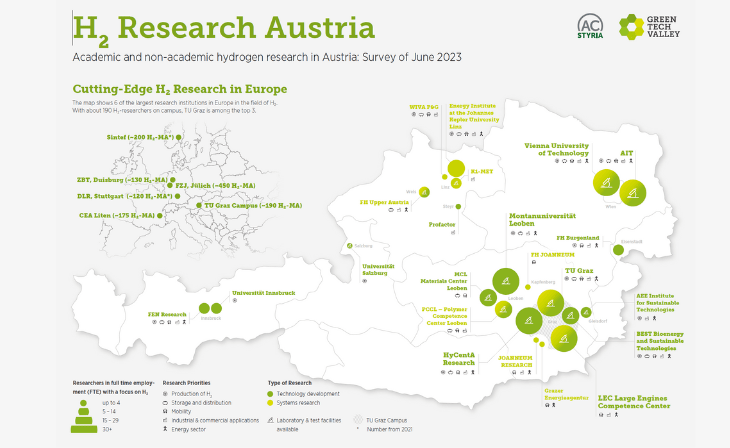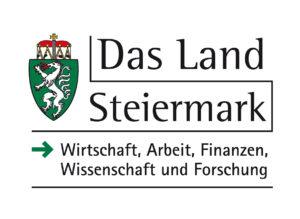Hydrogen Research Map
Austria
Green Tech Valley is The Hydrogen Hotspot
22 Austrian (non-)university institutions are among the top 3 in Europe for research into green hydrogen technologies. These competencies are bundled together in the current “H2 Research Map”. Conclusion: Styria accounts for around 60 percent of these pioneering achievements, the focus is shifting to industrial applications and the number of researchers has increased by around 50 (!) percent to almost 480 people.
As predicted, the EU Green Deal has led to a high level of dynamism and concentration for industrial, grid-supporting and mobile applications of hydrogen on the path to climate neutrality. This is also underlined by the latest update of the H2 Research Map Austria. Together with the mobility cluster ACstyria, the cluster organization of Green Tech Valley has taken a close look at Austria’s university and non-university research institutions – in order to bundle the thematic priorities, the size and equipment of the laboratories and the contact persons for cooperation with companies.
Sharp increase in researchers in hydrogen technologies
A total of 22 institutes with 478 hydrogen researchers (full-time equivalents) were recorded here across Austria. This represents an increase of around 50% compared to the last survey in 2021. What’s more, more than 60% of Austria’s hydrogen researchers are concentrated in the green market, followed by Vienna. With the K1 center HyCentA, the Large Engines Competence Center LEC and other TU Graz institutes with around 190 researchers in this field, the TU Graz campus is not only Austria’s hotspot in hydrogen research, but is also among the top 3 in the EU, after Jülich (Germany) and Sintef (Norway). Other national centers include the Bioenergy and Sustainable Technologies Competence Center (BEST, Graz), the University of Leoben and the Vienna University of Technology. These lighthouses, which are joined by other (non-)university development centers, together form the cornerstones of the H2 Research Map Austria.
Shift in focus towards industrial use
The research focus of the individual institutes and centers has shifted slightly in recent years, explains Bernhard Puttinger, Cluster Managing Director of Green Tech Valley: “The current issues have shifted from H2 production, storage & distribution to increased research activities on H2 use in industry. This shows that developments here are already going well beyond pure basic research and are being established in potential fields of application in cooperation with companies in the state.”
Research Minister Barbara Eibinger-Miedl emphasizes that this can only be achieved with a strong, joint effort: “Research, development and innovation are the basis for successfully mastering the green transformation. Hydrogen-based technologies in particular offer a wide range of opportunities here. Local universities, research centers and companies are working on numerous projects to continuously improve and expand the possible uses of hydrogen. This strengthens our position as a model region in this area.”
ACstyria Managing Director Thomas Krenn also emphasizes the great potential that hydrogen research holds for industry, especially in the automotive sector, and which must be exploited: “Sustainably produced hydrogen offers considerable potential, especially with regard to the decarbonization of the transport sector. As a result, the energy carrier has become considerably more important in recent years. We are convinced that hydrogen can make an important contribution to the sustainable transformation of mobility. We will play a key role in supporting this development in order to help create highly skilled jobs and promote innovation in this country.”
Still a lot of research to be done
There is still a lot to do. At present, 95 percent of the hydrogen used worldwide still comes from fossil energy sources, predominantly natural gas. This “gray hydrogen” must increasingly be replaced by “green hydrogen” from renewable sources such as solar power or biomass. As a climate-friendly energy carrier, H2 can be produced electrolytically, for example. This can be done emission-free with efficiencies of around 60 to 80 %.
At the moment, the production of green hydrogen is still very expensive. It currently costs two to three times as much as the production of gray hydrogen. Storing the colorless and odorless gas also has its pitfalls. Gaseous compressed hydrogen must be stored under high pressure in resistant containers, while liquid cryogenic hydrogen requires temperatures below -252.85 °C for transportation.
Companies and research institutes in Green Tech Valley are already working flat out on innovative solutions to overcome these challenges. Because one thing is clear: the use of green hydrogen is a building block on the road to the energy transition.
Downloads
Download full H2_Research-Map_en © Green Tech Valley Cluster
Your
Contact
Markus Simbürger
Green Tech Valley Cluster
+43 316/40 77 44-14
simbuerger@greentech.at
https://www.greentech.at









